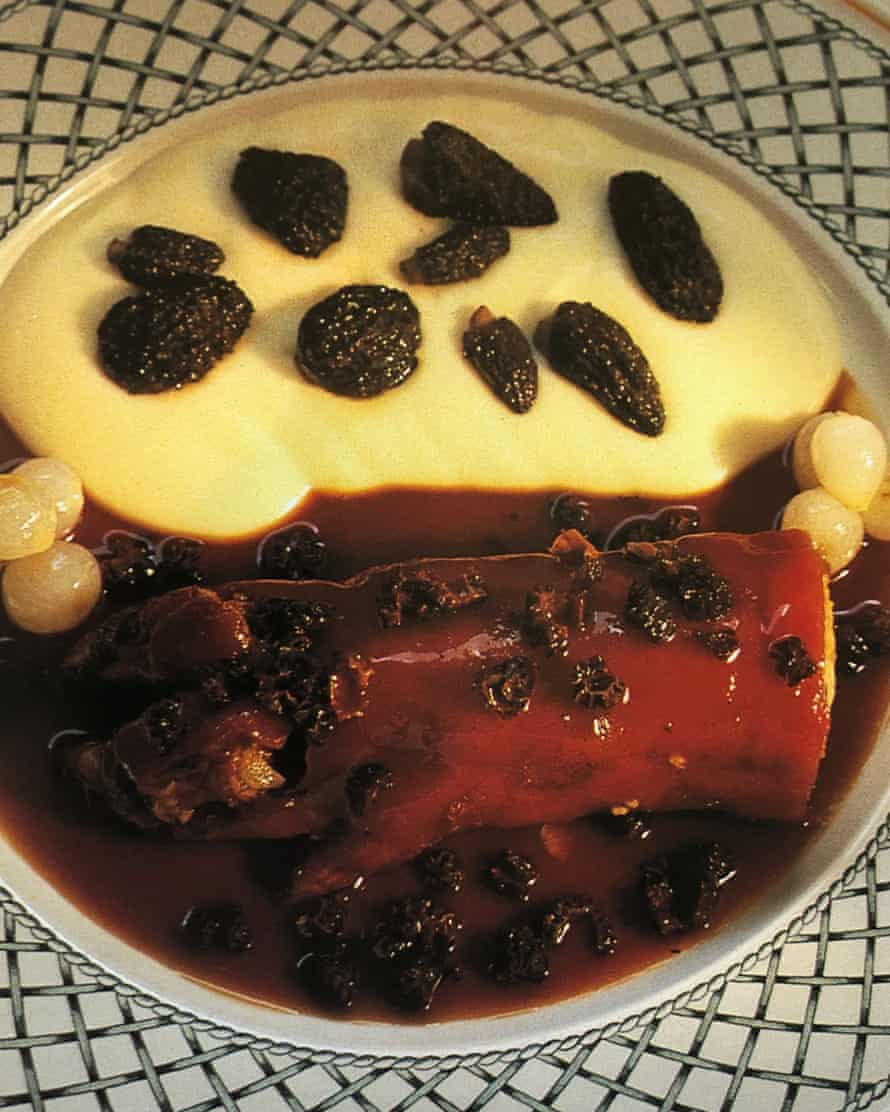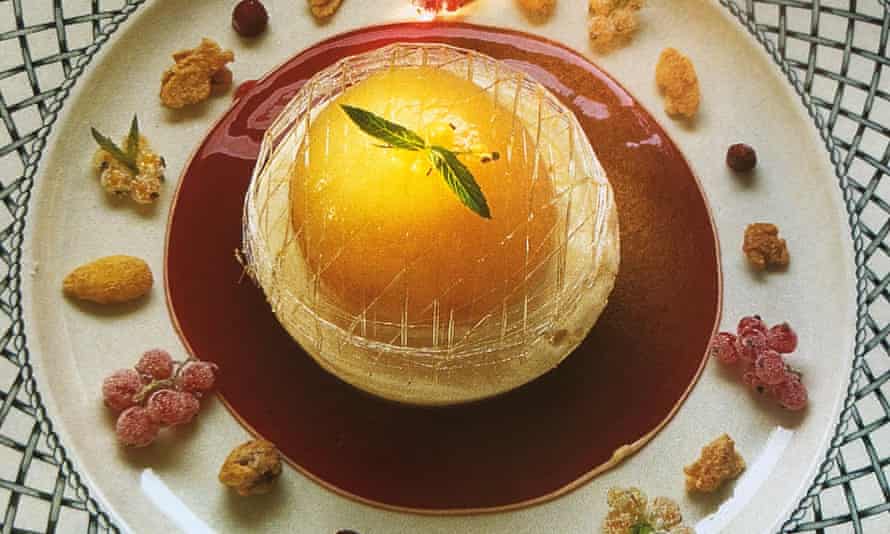Matt Tebbutt remembers exactly where he got his copy. “I found it in Whiteleys in Bayswater,” the chef and TV presenter says. “I was 17 years old, and it just resonated. It was cool and sexy. It was all about the glamour and excess.” Sat Bains, of the eponymous Michelin two-star in Nottingham, found his in a charity shop in the mid-90s. “I read the whole book in an hour and my head exploded. Who was this guy? He had this rock’n’roll attitude.” Chef Marianne Lumb says it’s her “bible”; Tom Kerridge describes it as a huge influence. The message is clear. For legions of chefs White Heat by Marco Pierre White isn’t a cookbook, though it does contain recipes. It’s a sacred text, only with added knives, flame and caviar.
Nobody has done a better job of obscuring the early, shimmering brilliance of Marco Pierre White than late-career Marco Pierre White. The gruelling kipper and whisky pâté I was served in one of his steakhouses in 2009 still repeats on me. There’s a growing chain of restaurants bearing his name which, while graced by vast pictures of the chef, are less often host to the man himself. Customer reviews have not always been positive. His 2006 ghost-written autobiography, about which I may not have been entirely polite in my review for this paper, was full of gloating accounts of angry outbursts and petty feuds. (To be fair, he’s not a big fan of mine either. He once announced that I was specifically not invited to his new restaurant in Cardiff’s Hotel Indigo.)
But none of that detracts from the impact made by Harveys, a small restaurant on Wandsworth Common, south-west London, which opened in 1987. It was the launch-pad from which White became the first British-born chef to win three Michelin stars. By the time Harveys opened he had already worked in Britain’s great classical restaurants: the Roux brothers’ Le Gavroche, Raymond Blanc’s Le Manoir and Pierre Koffmann’s La Tante Claire. Within weeks his own menu of outrageously luxe dishes – tagliatelle of oysters with caviar, feuilleté of roast rabbit with spring vegetables, a sugar-caged peach melba – was being talked about, feverishly.

The literary agent Mike Shaw was a regular customer from the start, along with the late Bob Carlos Clarke, the highly regarded photographer. They became intrigued by how these fabulous plates of food could be coming out of such a tiny kitchen. “Eventually Bob could restrain himself no longer,” Shaw says. “Small camera in hand he went to look, rushing back, expelled by Marco, complaining of the heat and the knives.” Later, White came out to chat, and from those conversations the idea for the book emerged. Shaw felt that “they ought to record all this before it vanishes into success. From the confusion, noise and heat came the title.”
Carlos Clarke became a fixture in the kitchen. “It was a tiny space,” says chef Stephen Terry, now of the Hardwick near Abergavenny, who was part of the original Harveys brigade, alongside Gordon Ramsay and Phil Howard. “Carlos Clarke was a lovely man but he was always getting in the fucking way.” What emerged from those shoots was a portfolio of iconic, grainy black and white shots which captured a moment. It helped, of course that, back then, White had cheekbones so sharp you could slice your hand on them. Plus, he was more than ready to step up to the role of chef as rockstar. Here are images of pans bursting with flame, of cooks rucking with each other, of White cutting huge scallops from the shell, his hand a blur.

Another page had pocket shots of celebrity diners like Koo Stark and Keith Floyd. And then, after the barely contained chaos of the front section, there are the food images by Michael Boys, a sudden gash of colour against the monochrome. “What I’ll always like about the food shots is the preciseness,” Stephen Terry says. “It all makes sense. It’s not messy.” White has often been described as the start of something. Given that the media flocked to him there’s no doubt he was. He was in the vanguard of a British restaurant revolution. But the French classicism of the food also makes him look like the end of something: 1987 also saw the opening of west London’s River Café and Kensington Place, both of which served the antitheses of his food.
What really gives the volume its rolling swagger, though, is the outrageous text. “You’re buying White Heat because you want to cook well? Because you want to cook Michelin stars? Forget it,” the introduction begins. “Go and buy a saucepan. You want ideas, inspiration, a bit of Marco? Then maybe you’ll get something out of the book.” He was barely 30 and he was already talking about himself in the third person. One brooding White image is captioned: “At the end of the day it’s just food, isn’t it?” It’s food he’s willing to dismiss out of hand. “This is disgusting; it’s a horrible dish,” he says alongside a shot of his assiette of chocolate. “It’s vulgarity pure and simple. It’s a dish invented for suburbia; it should be called ‘chocolate suburbia’.” Hilariously, Harveys was located on a suburban shopping parade.
I’m now meant to describe my cooking adventures with the book, but none of the chefs I spoke to said they had ever really executed any of the recipes. Nobody bought it to cook from. They bought it for a bit of Marco. It includes Pierre Koffmann’s pig’s trotter stuffed with a chicken mousseline. I made that last summer in lockdown, when I was missing restaurants and desperate. I don’t need to do it again. Instead, I have a crack at his lemon tart. The recipe is bizarre. Without saying so, it provides the ingredients for two tarts. Though it says it’s for a tart serving eight, it gives no tin measurement. The pastry is far too dry and unworkable. It’s almost as if Marco Pierre White wasn’t actually trying to provide a useful recipe. With improvisation I get something mildly edible, but I quickly conclude this really isn’t a cookbook for the likes of me. Or anyone for that matter.
In 2015, a 25th anniversary edition of White Heat was published, full of testimonials to the book’s brilliance by chefs it had influenced. One of those was the young lad from Nottingham who had only been able to afford it because he found it in a charity shop. “How mad is that?” Sat Bains says. Three decades on from its first publication there is no doubt: to a certain type of chef White Heat and Marco Pierre White still matter.
White Heat 25 by Marco Pierre White (Mitchell Beazley, £30) is available from guardianbookshop.com
News bites
Let’s kick off with some indulgence. Wiltshire Truffles which, like so many food companies, has moved from supplying restaurants to selling to the wider public, has started a partnership with Brett Graham, of the shuttered Ledbury. They’re selling a truffle cream, essentially a truffle-boosted mayo. A pound from each purchase goes to the homelessness charity Streetsmart. There’s also the Ledbury Truffle and Honey Ham at £45, made with legs of Windsor Park pigs, 20g of truffle and Aynhoe Park honey. Visit wiltshiretruffles.com.
Meanwhile Edinburgh’s much adored Gardener’s Cottage has introduced UK-wide delivery of their own smoked salmon, made from RSPCA-assured high welfare Scottish salmon, cured by hand. The Finish at Home Supper Kit costs £38 a head, and includes a starter of their beetroot cure oak-smoked salmon with wild garlic, smoked tomato and olive focaccia followed by smoked sea trout with asparagus and a lemon and thyme butter sauce (cottagepieandsmokehouse.co).
With enviable optimism, the 2021 summer festival circuit is showing signs of life. One of the most recent to announce is Bigfoot, which describes itself as the UK’s first craft beer and music festival, to be held this June at Ragley Hall in Warwickshire. For the purposes of this column, it’s the food offering that’s eye-catching, from restaurants such as 10 Greek Street and Patty & Bun, alongside a variety of chefs including Rovi’s Neil Campbell, Ramael Scully, Andrew Clarke and barbecue expert Genevieve Taylor. Visit bigfootfestival.co.uk.
Email Jay at jay.rayner@observer.co.uk or follow him on Twitter @jayrayner1
from Lifestyle | The Guardian https://ift.tt/30n8W8a
via IFTTT

comment 0 Comment
more_vert